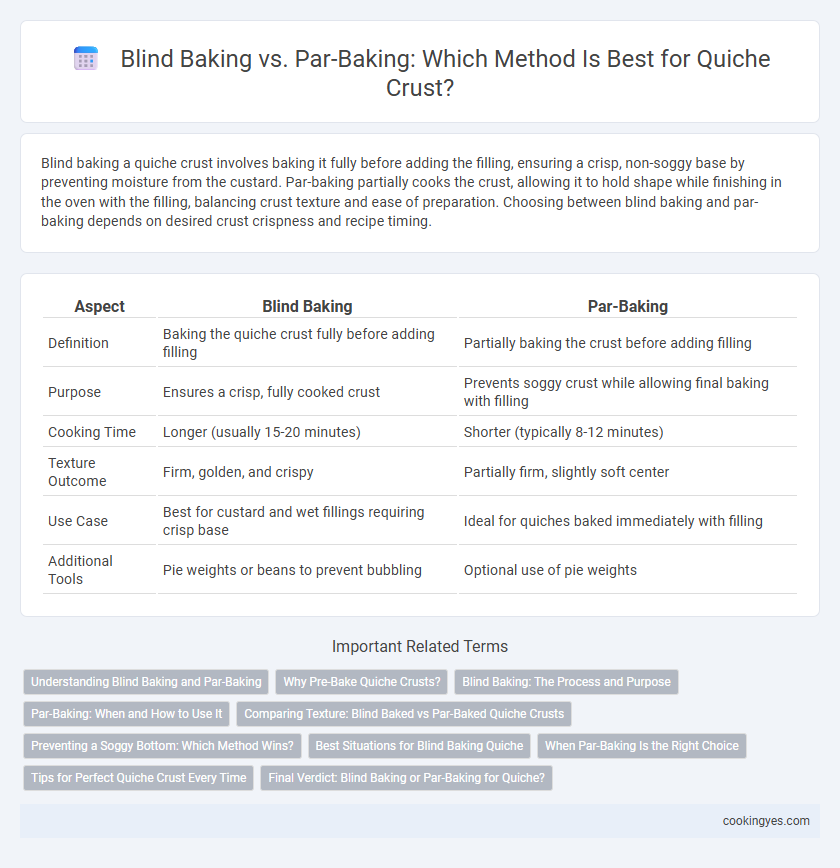Blind baking a quiche crust involves baking it fully before adding the filling, ensuring a crisp, non-soggy base by preventing moisture from the custard. Par-baking partially cooks the crust, allowing it to hold shape while finishing in the oven with the filling, balancing crust texture and ease of preparation. Choosing between blind baking and par-baking depends on desired crust crispness and recipe timing.
Table of Comparison
| Aspect | Blind Baking | Par-Baking |
|---|---|---|
| Definition | Baking the quiche crust fully before adding filling | Partially baking the crust before adding filling |
| Purpose | Ensures a crisp, fully cooked crust | Prevents soggy crust while allowing final baking with filling |
| Cooking Time | Longer (usually 15-20 minutes) | Shorter (typically 8-12 minutes) |
| Texture Outcome | Firm, golden, and crispy | Partially firm, slightly soft center |
| Use Case | Best for custard and wet fillings requiring crisp base | Ideal for quiches baked immediately with filling |
| Additional Tools | Pie weights or beans to prevent bubbling | Optional use of pie weights |
Understanding Blind Baking and Par-Baking
Blind baking involves baking the quiche crust without filling to prevent sogginess and ensure a crisp texture by using pie weights or beans to keep the dough flat. Par-baking partially bakes the crust, stopping before it is fully cooked, allowing it to finish baking with the filling to maintain a tender but firm base. Both techniques are essential for achieving a perfectly cooked quiche crust, depending on the moisture content of the filling and desired texture.
Why Pre-Bake Quiche Crusts?
Pre-baking quiche crusts, through blind baking or par-baking, prevents soggy bottoms by setting the dough before adding moist fillings. Blind baking involves baking the crust fully with pie weights to maintain shape, ensuring a crisp, firm texture ideal for custard-based quiches. Par-baking partially cooks the crust to allow final baking with the filling, balancing flakiness and avoiding overcooked pastry.
Blind Baking: The Process and Purpose
Blind baking a quiche crust involves pre-baking the pastry without filling to create a crisp, firm base that prevents sogginess caused by wet custard. The process typically includes lining the dough with parchment paper and filling it with pie weights or dried beans to maintain shape and avoid puffing. Blind baking ensures a golden, evenly cooked crust essential for the perfect texture and flavor balance in quiche.
Par-Baking: When and How to Use It
Par-baking quiche crust involves partially baking the dough before adding the filling, which helps maintain a crisp, non-soggy base while allowing the filling to cook thoroughly. Ideal for custard-based quiches, par-baking is typically done at 375degF (190degC) for 15-20 minutes until the crust sets and just begins to turn golden. Using pie weights or dried beans prevents bubbles and shrinkage during this process, ensuring an even and sturdy crust.
Comparing Texture: Blind Baked vs Par-Baked Quiche Crusts
Blind baking quiche crusts results in a crisp, fully cooked texture that prevents sogginess when filled with wet ingredients, ensuring a firm and sturdy base. Par-baking partially cooks the crust, leaving it slightly softer and more tender, which can sometimes cause a less distinct separation between crust and filling. For quiches requiring a flaky and crunchy crust, blind baking provides superior texture, while par-baking suits recipes emphasizing a more delicate crust consistency.
Preventing a Soggy Bottom: Which Method Wins?
Blind baking involves fully pre-baking the quiche crust before adding the filling, creating a firm barrier that prevents soggy bottoms by sealing the dough. Par-baking partially cooks the crust, allowing it to finish baking with the filling, which may not create as strong a barrier and can risk moisture absorption. For a perfectly crisp quiche crust, blind baking is generally the more effective technique to prevent sogginess.
Best Situations for Blind Baking Quiche
Blind baking quiche crust is ideal when using very wet custard fillings or incorporating delicate ingredients that require a fully crisp base to prevent sogginess. This method ensures a firm, golden crust by baking the dough without filling, allowing moisture-sensitive quiches to maintain structural integrity. It works best for recipes with watery vegetables, egg-based custards, or when the crust will be filled with pre-cooked ingredients.
When Par-Baking Is the Right Choice
Par-baking a quiche crust is the preferred method when you want a partially cooked base that remains tender yet firm enough to hold the custard filling without becoming soggy. This technique is especially effective for quiches with wetter fillings, such as those containing vegetables or cheeses releasing moisture during baking. Par-baking ensures even cooking and prevents the crust from shrinking or puffing up, maintaining a crisp, flaky texture essential for a perfect quiche.
Tips for Perfect Quiche Crust Every Time
Blind baking quiche crust involves fully baking the crust before adding the filling to prevent sogginess, ensuring a crisp and golden base. Par-baking, where the crust is partially baked, helps maintain structure while allowing some moisture absorption from the filling, ideal for delicate quiche recipes. Use pie weights during blind baking to avoid puffing, and chill the dough before baking to prevent shrinkage for a perfect quiche crust every time.
Final Verdict: Blind Baking or Par-Baking for Quiche?
Blind baking quiche crust ensures a fully cooked, crisp base that prevents sogginess when adding wet fillings, making it ideal for delicate custard textures. Par-baking partially cooks the crust, offering a slightly softer texture while providing structure, suitable for quiches with a more substantial filling or shorter baking times. For optimal results, blind baking is recommended to achieve a firm, golden crust that maintains integrity and enhances the overall quiche experience.
Blind baking vs par-baking for quiche crust Infographic

 cookingyes.com
cookingyes.com